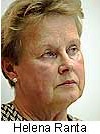
Helena Ranta testifies
at Milosevic trial in The Hague
Helsingen Sanomat
March 13, 2003
Former Yugoslav
President accuses Finn of involvement in NATO conspiracy
| At his ongoing trial
for genocide and other crimes, Former Yugoslav President Slobodan
Milosevic attempted on Tuesday to demonstrate that the Albanians killed by Serb
forces in the Kosovo village of Racak were combatants of the Kosovo Liberation
Army, and not the civilian victims of a massacre as has been claimed. |
 |
In the courtroom of the
United Nations war crimes tribunal in The Hague, Milosevic said that Finnish
forensic dentist Helena Ranta had been manipulated to write a report on the
events in Racak which paved the way for the NATO bombings of Serbia and Kosovo
in 1999.
Testifying at the trial
on Tuesday, Ranta sharply denied being the target of any kind of manipulation.
Finland's Ministry for
Foreign Affairs had been asked about the content of Ranta's secret report. The
report was a key reason for the NATO decision to start the bombing campaign.
The Finnish forensic
team led by Ranta
investigated the massacre in Racak in 1999. One of the victims was a young
woman, another a young boy, and the rest were men. The investigators did not
find any evidence to suggest that the dead were combatants.
Milosevic tried to put
forward a conspiracy theory according to which Germany, as well as William
Walker, ambassador of the Organisation of Security and Cooperation in Europe
(OSCE), had put pressure on Ranta.
In her testimony Ranta
pointed out that all of the members of her team were Finns, and that Finland is
not even a member of NATO.
She emphasised that she
was in Kosovo exclusively to determine the causes of death of those who were
killed, without consideration of the possible political repercussions of her
report.
At Tuesday's session of the trial, Milosevic
also focused on reports by Serb investigators who said that there were powder
burn marks on the hands of 37 of the 40 bodies. He saw this of an indication
that the dead were fighters, and not civilians.
Ranta rejected the
findings, pointing out that they were based on a paraffin test which had been
used already in the 1930s, and which she did not consider reliable. Ranta's
group did not conduct any powder burn tests, because they were not able to study
the bodies until a week after the victims had died. She said that such tests
should be conducted within three to six hours after the shots had been fired.
Milosevic also showed
pictures of an ammunition cartridge and a military identification tag, saying
that they were further evidence that the victims were fighters.
According to the Ranta
report, all of the bullets found by the Finnish investigators were found in the
ground directly beneath the bodies. In an ordinary combat situation the bullets
would have been more likely to penetrate the bodies, flying further away.
The bullets found
inside the bodies were taken by the Serb investigators.
Ranta was visibly
relieved after her testimony.
She said that she had expected a tougher grilling. She had prepared for the
questioning by undergoing about half a dozen sessions of mock testimony in
Helsinki.
Ranta says that she had
anticipated some of Milosevic's claims - including the ones in which the Serb
investigators found powder burns on the hands.
"I knew that Milosevic
might launch an active attack. Fortunately judge Richard May interrupted him",
Ranta said later on.
Ranta never made eye
contact with Milosevic, and was
not intimidated by his tough cross-examination. Instead, she asked the defendant
to be more precise in his questioning.
One expert praised her
performance on the witness stand.
"Her testimony was very
good, clear, scientific, and professional", said Judith Armatta, a
representative of the Coalition of International Justice.
Armatta said that the
testimony was important for clearing the air of claims that Ranta had
characterised the events in Racak as a "massacre".
"The events in Racak
are among the key issues at the Milosevic trial, and that is why Ranta's
testimony was important", Armatta says.
In addition to Racak,
Ranta has been involved in a number of high-profile investigations, including
that of bones removed from the grave of the family of the last Russian Czar, the
remains of Finnish soldiers found in old wartime battlefields in Russia, and
victims of the sinking of the passenger ferry Estonia.
The first time that she
investigated a massacre was in Bosnia. Now Ranta is set to go to Peru to serve
in an advisory capacity.